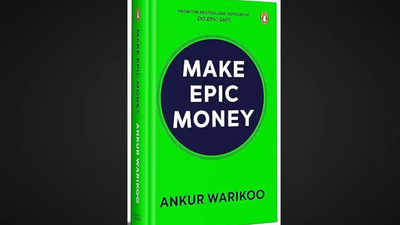Trending
Plan better this upcoming Financial Year with Ankur Warikoo’s new book ‘Make Epic Money’
Ankur Warikoo's 'Make Epic Money' provides comprehensive financial guidance, covering topics like assets, liabilities, credit card management, loan interest reduction, renting versus owning, and investment strategies for a secure financial future.

Make Epic Money (Image: Penguin Random House India)
As we enter a new financial year, the days leading up to it, and the early ones, give people the perfect opportunity to think about and plan their money, savings, and spending wisely. Be it cutting down on rent to investing more in the market, the start of the new financial year brings with it new hopes and aspirations for people.
And with the start of every financial new year, there comes a plethora of information and influencers online trying to make you understand how to make, save, and grow money the right way.While some advice is great, others can be rather misleading.
And so, if you too want to escape this maze of excess information and focus on one perfect source to help you with managing your finances, Ankur Warikoo has come up with his new book ‘Make Epic Money’. Covering topics like financial literacy, savings, investments, budgeting, and earning strategies, the book gives valuable insights into everyday life to help you plan better right from the beginning of the next financial year.

Understand the difference between assets and liabilities
Delving into the significance of financial literacy, Warikoo explains the difference between earning a living and growing one’s wealth. “The truth is that professional degrees help you earn a living, and financial literacy helps you build wealth.” He brings forth his key insights on what one must do to keep away from any kind of liabilities and provides practical solutions to invest in assets in the best possible way. He emphasises, “Don’t just look at the price tag, see the full cost of ownership. If it costs you money and loses value, it is a liability. Aim to get assets that generate cash flow, assets that earn you money while you chill, assets that cover your expenses and assets that let you do the things you want to do. Keep liabilities to a minimum."
Find ways to boost income opportunities when young
Drawing from his experiences, Ankur imparts invaluable insights on effective financial planning, offering a roadmap to the youth to budget their income methodically to secure their financial future. “If you are in your 20s and your income is less than 3 lakhs per annum, you have time. Take risks and find ways to boost your income. First is financial protection and emergency funds. Build it for three months. Health insurance for your parents - they need it. You can be without one right now. Life insurance can wait till your 30s or till your income exceeds nine lakhs. Don’t spend more than 20% of your desires on this income. You can’t afford to spend more than 20% of your monthly salary after tax. Find ways to increase your income. Look for other active and passive income opportunities. Invest at least 30% of your income. Time is your biggest asset. Most of your portfolio should go into the stock market to maximise the power of compounding and get yourself higher returns.” he says. To supplement the living you earn from your day job, Ankur encourages listeners to set up multiple income streams. He urges, “Stay in your current job, use your salary as a safety net. This way, there is no pressure to make money off your other income streams. Then take out time from your day job. The ultimate goal is to move towards a passive income stream where you don’t have to spend your time to make money. Instead, your knowledge, your skill, your process and your money make money for you through your assets.” he says.
Beware of the credit card trap
Ankur advocates for prudent financial habits by encouraging listeners to remain debt-free. He emphasises the importance of responsible usage of credit cards, advising individuals to consistently settle their credit card balances in full to avoid accruing unnecessary interest charges. Sharing the consequences of falling into the minimum amount trap, he says “The outstanding amount accrues interest, your debt escalates, your due payment increases plus your credit rating is affected. Credit cards give you the illusion of free money.” He also teaches listeners how they can use credit cards to make money. “Number 1 - Interest-free loans. Credit cards offer a 30-45 day interest-free period. It’s like a mini loan for whatever you need. So if you make a big purchase using a card early in the month, invest that amount in a short-term debt fund. You earn some happy money for free. Number 2 - Improved credit score. Your credit score, which is also called the CIBIL score determines creditworthiness. It increases based on how consistently you pay off your loans and how many loans you have. A higher score is equal to a better credit profile. So if you pay your credit card bill on time and in full, your rating builds and improves. A better rating means VIP loan treatment in the future. You get a lower rate of interest and save money in the long run. Number 3 - Reward points. Redeem rewards points for air miles, free tickets, hotel stays, gift cards, cashback and more. Explore and make the most of these freebies.” Sharing a pro tip, he suggests opting for a credit card with 0 yearly charges or one that is backed by a fixed deposit when applying for it for the first time.
Save interest on loans by reducing the loan tenure
When taking loans to purchase big-ticket items, it can be stressful to shell out money every month, not just to repay the principal amount but also the interest to the bank. Sharing a quick tip to get rid of the loan sooner, Ankur shares a trick to save the interest on loans. He says, “The only principle you need to know - reduce the loan tenure so you can reduce the interest you pay". Sharing an example of paying off a 25-year loan in just 10 years, he shares, “In the initial phase, you pay more interest and less principal so the banks reap profits. Over time, you pay more principal and the interest declines. The trick is to slash your interest costs as early as possible. There are two ways to save interest on loans. Number 1 - pay extra EMIs every year and number 2 - keep increasing your EMI every year. Every year if you pay 1 extra EMI, so instead of 12 EMIs you pay 13 EMIs plus increase your original EMI amount by 5% every year, you will clear your 25-year loan in just 12.5 years. What if you increase your EMIs by 10%? You will clear your 25-year loan in just 10 years. You will also save 50% in interest that you would’ve paid over 25 years. The best part - it doesn’t matter what the loan amount is.”
Renting vs Owning a house? Find out what’s better!
Addressing the perennial question of buying versus renting a home, Ankur challenges the conventional thought process that owning a house is the wisest financial decision and ultimate life achievement. To prove how the decision to purchase a home is often driven more by emotion than financial reasoning, he explains the concept of rental yield as a key factor in evaluating the financial implications of renting versus buying. He says, “Rental yield is equal to the annual rent you pay divided by the property value multiplied by 100.” Citing an example of a house worth INR 1 crore with a monthly rent of INR 20,000 he calculates further, “You pay INR 20,000 a month as rent which is equal to 2.4 lakhs over the entire year and when you divide it by 1 crore, you’re essentially paying 2.4% of the house value as rent every year. Yes, you’re living the 1 crore life at 2.4% annual cost.” As he continues to dissect the financial dynamics with clarity and precision, Ankur encourages listeners to approach the decision practically and consider both the house value and the rent growing evenly in the future. In the case of renting, the key expense is the monthly rent while the cost associated with buying comprises the down payment which is around 20-25% of the value, the EMI and the interest, the registration cost which varies between 3-7% of the home cost, the brokerage fees that is usually 1% of the home cost and the maintenance cost. He adds, “When you add up all of these costs, you end up paying nearly 3 times of the home price over a 20-year period.” He recommends, “Invest the down payment for the next 10 years as a lump sum amount. Invest the difference between what would have been your home loan EMI and the rent as a monthly SIP. Then over a 10-year period, you will build enough corpus to buy nearly 50-70% of your dream home on a down payment.” Hence, he proves how renting can provide one with a higher standard of living within the budget because rental yields are very low in India, proving monthly rent is kinder to one’s wallet.
And with the start of every financial new year, there comes a plethora of information and influencers online trying to make you understand how to make, save, and grow money the right way.While some advice is great, others can be rather misleading.
And so, if you too want to escape this maze of excess information and focus on one perfect source to help you with managing your finances, Ankur Warikoo has come up with his new book ‘Make Epic Money’. Covering topics like financial literacy, savings, investments, budgeting, and earning strategies, the book gives valuable insights into everyday life to help you plan better right from the beginning of the next financial year.

Ankur Warikoo book signing (Image: ankurwarikoo/Instagram)
Here are five tips from Ankur Warikoo's ‘Make Epic Money’, as shared by Audible.
Understand the difference between assets and liabilities
Delving into the significance of financial literacy, Warikoo explains the difference between earning a living and growing one’s wealth. “The truth is that professional degrees help you earn a living, and financial literacy helps you build wealth.” He brings forth his key insights on what one must do to keep away from any kind of liabilities and provides practical solutions to invest in assets in the best possible way. He emphasises, “Don’t just look at the price tag, see the full cost of ownership. If it costs you money and loses value, it is a liability. Aim to get assets that generate cash flow, assets that earn you money while you chill, assets that cover your expenses and assets that let you do the things you want to do. Keep liabilities to a minimum."
Find ways to boost income opportunities when young
Drawing from his experiences, Ankur imparts invaluable insights on effective financial planning, offering a roadmap to the youth to budget their income methodically to secure their financial future. “If you are in your 20s and your income is less than 3 lakhs per annum, you have time. Take risks and find ways to boost your income. First is financial protection and emergency funds. Build it for three months. Health insurance for your parents - they need it. You can be without one right now. Life insurance can wait till your 30s or till your income exceeds nine lakhs. Don’t spend more than 20% of your desires on this income. You can’t afford to spend more than 20% of your monthly salary after tax. Find ways to increase your income. Look for other active and passive income opportunities. Invest at least 30% of your income. Time is your biggest asset. Most of your portfolio should go into the stock market to maximise the power of compounding and get yourself higher returns.” he says. To supplement the living you earn from your day job, Ankur encourages listeners to set up multiple income streams. He urges, “Stay in your current job, use your salary as a safety net. This way, there is no pressure to make money off your other income streams. Then take out time from your day job. The ultimate goal is to move towards a passive income stream where you don’t have to spend your time to make money. Instead, your knowledge, your skill, your process and your money make money for you through your assets.” he says.
Beware of the credit card trap
Ankur advocates for prudent financial habits by encouraging listeners to remain debt-free. He emphasises the importance of responsible usage of credit cards, advising individuals to consistently settle their credit card balances in full to avoid accruing unnecessary interest charges. Sharing the consequences of falling into the minimum amount trap, he says “The outstanding amount accrues interest, your debt escalates, your due payment increases plus your credit rating is affected. Credit cards give you the illusion of free money.” He also teaches listeners how they can use credit cards to make money. “Number 1 - Interest-free loans. Credit cards offer a 30-45 day interest-free period. It’s like a mini loan for whatever you need. So if you make a big purchase using a card early in the month, invest that amount in a short-term debt fund. You earn some happy money for free. Number 2 - Improved credit score. Your credit score, which is also called the CIBIL score determines creditworthiness. It increases based on how consistently you pay off your loans and how many loans you have. A higher score is equal to a better credit profile. So if you pay your credit card bill on time and in full, your rating builds and improves. A better rating means VIP loan treatment in the future. You get a lower rate of interest and save money in the long run. Number 3 - Reward points. Redeem rewards points for air miles, free tickets, hotel stays, gift cards, cashback and more. Explore and make the most of these freebies.” Sharing a pro tip, he suggests opting for a credit card with 0 yearly charges or one that is backed by a fixed deposit when applying for it for the first time.
Save interest on loans by reducing the loan tenure
When taking loans to purchase big-ticket items, it can be stressful to shell out money every month, not just to repay the principal amount but also the interest to the bank. Sharing a quick tip to get rid of the loan sooner, Ankur shares a trick to save the interest on loans. He says, “The only principle you need to know - reduce the loan tenure so you can reduce the interest you pay". Sharing an example of paying off a 25-year loan in just 10 years, he shares, “In the initial phase, you pay more interest and less principal so the banks reap profits. Over time, you pay more principal and the interest declines. The trick is to slash your interest costs as early as possible. There are two ways to save interest on loans. Number 1 - pay extra EMIs every year and number 2 - keep increasing your EMI every year. Every year if you pay 1 extra EMI, so instead of 12 EMIs you pay 13 EMIs plus increase your original EMI amount by 5% every year, you will clear your 25-year loan in just 12.5 years. What if you increase your EMIs by 10%? You will clear your 25-year loan in just 10 years. You will also save 50% in interest that you would’ve paid over 25 years. The best part - it doesn’t matter what the loan amount is.”
Renting vs Owning a house? Find out what’s better!
Addressing the perennial question of buying versus renting a home, Ankur challenges the conventional thought process that owning a house is the wisest financial decision and ultimate life achievement. To prove how the decision to purchase a home is often driven more by emotion than financial reasoning, he explains the concept of rental yield as a key factor in evaluating the financial implications of renting versus buying. He says, “Rental yield is equal to the annual rent you pay divided by the property value multiplied by 100.” Citing an example of a house worth INR 1 crore with a monthly rent of INR 20,000 he calculates further, “You pay INR 20,000 a month as rent which is equal to 2.4 lakhs over the entire year and when you divide it by 1 crore, you’re essentially paying 2.4% of the house value as rent every year. Yes, you’re living the 1 crore life at 2.4% annual cost.” As he continues to dissect the financial dynamics with clarity and precision, Ankur encourages listeners to approach the decision practically and consider both the house value and the rent growing evenly in the future. In the case of renting, the key expense is the monthly rent while the cost associated with buying comprises the down payment which is around 20-25% of the value, the EMI and the interest, the registration cost which varies between 3-7% of the home cost, the brokerage fees that is usually 1% of the home cost and the maintenance cost. He adds, “When you add up all of these costs, you end up paying nearly 3 times of the home price over a 20-year period.” He recommends, “Invest the down payment for the next 10 years as a lump sum amount. Invest the difference between what would have been your home loan EMI and the rent as a monthly SIP. Then over a 10-year period, you will build enough corpus to buy nearly 50-70% of your dream home on a down payment.” Hence, he proves how renting can provide one with a higher standard of living within the budget because rental yields are very low in India, proving monthly rent is kinder to one’s wallet.
End of Article
FOLLOW US ON SOCIAL MEDIA









